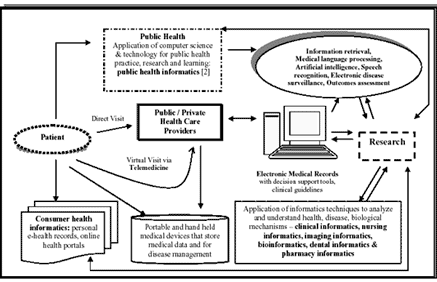Dr. Sripriya Rajamani
Health informatics is a scientific discipline which focuses on the acquisition, storage and utilization of health-related data and information. The aim is to translate the data and information into knowledge and apply this for problem solving and decision making [1]. Health care is a data intense field and the effective management of medical data and information will increase efficiency of process, influence better outcomes and enhance the quality of health care. These health data also form a vital element of health care planning, policy and research.
The field of health informatics is multi-disciplinary comprising of computational, cognitive, management and other sciences. Various methods and tools of information technology and computer science are being used to support various tasks and to automate certain processes. A new generation of information systems and applications are currently being developed aimed at health care networks, physicians, health care managers and public health. The power of health care informatics is being realized and health institutions are beginning to make large-scale commitments to information systems. This field has developed into a distinct entity and academic departments are being established to train medical informatics professionals.
Health informatics has the power to revolutionize health care. Advances in computing hardware and software translate into better multimedia applications, wireless communications and ability to store and retrieve enormous amounts of data. The role of health informatics is broad and ranges from application of advanced data analytical methods, artificial intelligence techniques, medical language processing, assessment of health outcomes to electronic surveillance for selected risk factors and diseases. The application of informatics techniques to understand health, disease and biological mechanisms which focus on specific areas of biomedical science or health care has led to the development of many sub-domains (figure 1).
Advancements in the field translate into innovative methods and solutions in health care. Some advantages are:
Physician
- Electronic medical records that facilitate the access to the medical record of a patient at anytime and place.
- Clinical decision support systems / intelligent systems that assist in prescribing of medications, interpretations of lab results, disease surveillance and suggest plans of action in data-intense areas like the intensive care units.
- Portable and miniature hand held devices that enable to access patient data anytime and also provide medical news and information.
- Telemedicine that provides the ability to attend to patients who are separated by distance and those who are unable to visit the physician.
Patient
Electronic personal health records that enable to store essential medical information.
Telemedicine which connects patient with medical experts far away.
Websites that provide information on health, diseases and self-help.
Online support groups specific for various health conditions.
Internet-based tools for disease management.
Researchers and Policy Makers
- Tools to collect, manage, store and analyze huge amount of data and translate it into effective information that can be used for planning and allocation of resources.
- Innovative methods and technologies that provide the ability to answer interesting and challenging research questions and explore new avenues for solving health problems.
The many specializations in health informatics, the various entities in the field and their relationships are depicted in figure 2. Knowledge management [3] focuses on the knowledge embedded in these various processes, combined with people, organizational and external resources and utilizing it for effective clinical and policy decisions.

To tap the many benefits of health informatics, to encourage wider adoption of health information systems and for a smoother transition from legacy systems, standards in terminology and tools are vital and need to be promoted. Effective leadership and well-trained health informatics professionals are key factors in technology diffusion and adoption.
The field has its set of challenges which need to be overcome. Financial costs and affordability of new health information systems, organizational factors, digital divide, privacy regulations, data security policies and responsibility for public health are issues that ought to be addressed.
It is time to realize the potential of health informatics and tap its ability to transform and improve health care.
References
- Shortliffe EH, Perreault LE. Medical Informatics: Computer Applications in Health Care and Biomedicine. second ed: Springer-Verlag; 2000.
- Yasnoff WA, Carroll PW, Koo D, Linkins RW, Kilbourne EM. Public Health Informatics: Improving and Transforming Public Health in the Information Age. Journal of Public Health Management and Practice. 2000;6(6):67-75.
- Alavi M, Leidner DE. Review: Knowledge Management and Knowledge Management Systems: Conceptual Foundations and Research Issues. MIS Quarterly. 2001;25(1):107-136.

